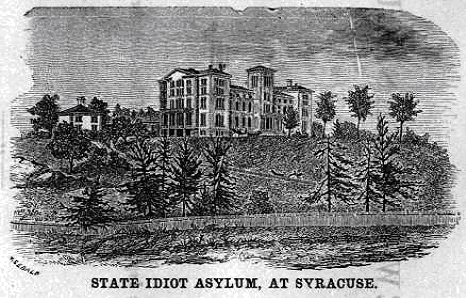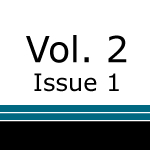Epideictic Rhetoric and the Reinvention of Disability: A Study of Ceremony at the New York State Asylum for “Idiots”
Article PDF
Kenneth Burke once asked, Does an event’s final position necessarily transcend its position at the start? (422). This question drives my examination of changes in narratives of disability over time (Garland-Thomson and Holmes 74). I look to the 1854 opening ceremony and the 1998 closing ceremony of The New York State Asylum for “Idiots” (the Syracuse Developmental Center), an institution where medical intervention converged with education in an effort to overhaul the civic, moral, physical, and mental aspects of the “idiot.” Within the span of 144 years, the “idiot” was reinvented as the “intellectually disabled person.” This brief analysis steers attention in medical rhetoric towards what Gilman calls “the attendant social and cultural settings” of medicine (72). A host of scholars (Barton, Berkenkotter and Hanganu-Bresch, Segal, and Wells) argue that medicine is always embedded in cultural histories and social understandings. Similar to how Wells demonstrates ways in which women’s social movements change the course of medicine (8-9, 15), I point to ways in which transformations in the rhetoric of praise and blame impelled the redesign of a treatment paradigm, and thus reinvented how we think of disability.
Opening and closing ceremonies as epideictic rhetoric are especially generative for assessing changes over time. One study of epideictic rhetoric within a medical framework by Keranen utilizes a comparative historiographic analysis. Keranen concludes that the Hippocratic Oath, due to its antiquated nature, does not accurately match our present, shared values; rather, an oath that adhered to contemporary standards would praise autonomy, justice, rigorous research, and collaborative medicine (66). In a cognate study, Segal discusses how narrative pathography (illness stories) praise optimism and family values but reproach the disorganized, silent patient. Segal reinforces our understanding of epideictic rhetoric as that which praises and blames and thus creates and maintains shared values (61, 72).
These interpretations of epideictic rhetoric in medical discourse are invaluable; nevertheless, analyzing ceremonial rhetoric with regards to intellectual disability is indeed an elephant in the room. Classically, epideictic rhetoric typically involves the funeral oration, which praises the virtue and heroism of the dead. For Aristotle, epideictic praises virtues in people or events that include “justice, manly courage, self-control, magnificence . . . gentleness, prudence, and wisdom” (80). I, however, use epideictic rhetoric to examine how the intellectually disabled person was over time constructed and deconstructed via praise and blame: both ceremonies create unique narratives of the sentimental and of Enlightenment principles of universal rights and neither utilize what Jerome Bruner calls the discourse of logico-scientific positivism.1 Sentimentalism and benevolence underscore the 1854 ceremony in a manner that lauds the institution and pities the patient; conversely, the 1998 ceremony cogently asserts patients’ rights. In 1998, community collaboration and autonomy of the patient are idealized, and the institution is rebuked for its incompetence. Both ceremonies, however, impress upon the need for humanity and the need for the patients’ civic and social advancement. The ceremonies tell their respective stories as narrative arguments that may not have scientific verifiability but indeed deepen our understanding of the social and cultural aspects of medicine.
To demonstrate these changes in narratives of “idiocy” and intellectual disability, I utilize Annual Reports (A.R.), Census Reports, and newspaper accounts from the nineteenth century as well as newspaper accounts, first person accounts, and a recent interview.2 While I do attempt to interpret the ceremonies “on their own terms,” that feat is historiographically impossible. I do, however, utilize an annotated version of Barton’s method of extracting rich text features, identifying textual patterns, and situating them within cultural and historical frameworks (67, 75).
Background and the Medico-Pedagogic
In its early days, The New York State Asylum for Idiots admitted those with the medical diagnosis of “idiot.” Binet’s intelligence scale, which developed into the IQ test, was not officially used until 1905; thus, assessment of physiologic function and appearance determined a sense of intelligence until, and arguably even after, the early twentieth century (Fletcher-Janzen and Reynolds 407; Annual). In the asylum-school’s opening in 1854, 50 patients, most under the age of 18, were admitted. In 1855, 89 attended the asylum-school (Census). At the asylum-school, Edouard Seguin, a French physician, had come to the U.S. in 1848 and helped implement his “Physiological Treatment” as the medico-pedagogic method used. At the Asylum, “moral treatment” entailed schooling in social decorum, appearances, and worldly endeavors. Patients also studied math, writing, reading, music, and geography; they were taught how to cane chairs and weave and perform domestic labor, farm work, and carpentry. The curriculum also involved medical and physiological treatments similar to what we now think of as physical therapy, speech therapy, occupational therapy, and orthopedic surgery.
By the 1880s, industrial education took precedence over academics (Annual). By 1931, 1,437 people of all ages lived and worked at the school and at 13 allied colonies (Census). In 1969, the first group home in the community was established followed by the building of a new, smaller facility (called the Syracuse Developmental Center). In 1975, residents formed their own council inside the institution and began to organize alongside the Self-Advocacy Movement (see http://sanys.org/). Reports of abuse and neglect grew; meanwhile, there was the nationally publicized closure of Willowbrook in Staten Island in 1987. In 1998, after years of community advocacy and civil rights legislation, the last five residents moved into group homes and “independent living” residences. There, people received case management, cultural integration, and medical support across a broad continuum in terms of both quantity and quality (Center). In recounting the ceremonies that span 144 years and in looking closely at textual features, an epistemic shift is revealed.
The Opening Ceremony, 1854
The official opening of the Asylum in Syracuse on September 8, 1854 was attended by several hundred citizens who gathered to lay the building’s cornerstone as part of what would be reported as a “noble” and “benevolent” occasion (Daily). On the Friday of the opening, many prominent men of the city and state arrived. Ladies were present, though their names are left out of the event’s record, and not one patient of the 89 who were admitted in 1855 is recorded to have attended the event. Among the men present were the Mayor, the Secretary of State, President of Syracuse Savings, the ex-governor, City Council members, and the abolitionist Reverend Samuel May. The institution and the land it was on, it was thought, would bring “asylum” (from the Latin for “refuge”) in the most idyllic way to those who needed it. The vision was to heal the “suffering” and rescue them from their “doomed” state. Sentimentalism and religiosity praised and elevated the institution, its architects, the land, the curriculum, and the physicians. Patients would not be extolled until later: here, their defects would be highlighted in order to demonstrate a desperate need for treatment, refuge and, of course, funding from the state.

At the cornerlaying ceremony, interspersed between speeches by the prominent men who attended, Reverend May adapted religious hymns that lauded this work of charity (Annual 180-83). May also spoke about the nature of the “malady”: “But there was idiocy—idiocy so appalling in its appearance, so hopeless in its nature; what could be the use of such an evil? . . . I ventured, therefore, to declare, with an emphasis enhanced . . . that the time would come when access would be found to the idiotic brain, the light of intelligence admitted into its dark chambers, and the whole race be benefited by some new discovery of the nature of mind” (Annual 216). The patient’s “dark chamber” needs light. The patient is “appalling,” “hopeless” and there is no “access” into the mind until treatment is received.
The hymn, May’s remarks, and the ceremony in general,3 illustrate what was valued: in May’s sanctifying of the school, the building, the physicians, and the endeavor are exalted while the patients are in need of spiritual, medical, and educational deliverance. The incoming patients are “chosen friends (emphasis added) of our Lord Jesus”; the school’s opening constituted the fulfillment of a sanctimonious prophesy that would, through the enlightenment of moral treatment, uplift degraded patients out of their misery. Dr. Seguin testifies, “See that stone—the token of a new alliance between humanity and a class hitherto neglected—that, ladies and gentlemen, is your pride; it is the greatest joy of my life, for I, too, have labored for the poor idiot” (Annual 208). In the language of today, these sentiments might seem harsh and exaggerated; however, these educators and physicians were (and still are) seen as progressive reformers who had advocated for what was thought of as optimal care.
The ex-governor of New York testified with a similar tone that pathologizes the patient: the idiot, prior to the construction of this asylum, used to be “inexorable,” “doomed to a state of debasement,” and “too profound for amelioration” (Annual 187). But now, as Dr. Sequin testified, the goal is to build “palaces for the indigent” (207, emphasis added). One prominent figure after another confirmed an epiphany: the medico-pedagogic could transform “poor creatures,” “debased souls”, and “unfortunates,” into harmonized and contributing citizens who could perform ordinary duty, maintain individual rights, and develop connections between self and community. These select words, alongside longer passages, demonstrate an evaluative move to heal what is thought to be “corrupted” and “infirm” and to bring people into humanity’s fold.
The opening ceremony indeed makes a case for the asylum as a noble and benevolent endeavor: the ceremony corrals public sentiment utilizing the language of benevolence and divine providence. In an 1858 visit, the Board of Supervisors agreed publicly that, “It is indeed a noble institution” (Daily). The asylum era in Syracuse was born by way of ceremonial acts, not of the logico-scientific, but of stately and gallant visions that exalted the founders, the land, and the endeavor. The “hallowed ground,” the building, the architects, and the physicians/educators are righteous and ignoble. The patients are infirm and in desperate need of treatment, but they can at last enter humanity. “Idiocy,” abject and the cause of much suffering, can be ameliorated with medical intervention.
The Closing Ceremony, 1998
After 144 years of operation, at 10:30 am, June 17, 1998, the Syracuse Developmental Center (SDC) closed its doors. A communal sigh of relief resounded. The ceremony’s title signified hope: “As One Door Closes, Many Open: Ceremony to Mark the Closure of the Syracuse Developmental Center.” Many were “relieved”; everyone celebrated. The Syracuse Post-Standard reported that over 1,500 people turned out to “share in the celebration.” So many people came that the organizers mounted television monitors throughout the building for those who could not fit into the third floor gym (Weibezahl).

Everyone who spoke condemned the custodial treatment model that had gained ground in the 1880s and then continued to take hold through the twentieth century. Speakers praised people’s independent spirit and coalition building which drove community inclusion that came about as a result of the civil rights, patients’ rights, and disability rights movements. The rhetoric of “sharing” reflected that consensus had formed horizontally among mental health professionals, physicians, social workers, families, and residents alike: this coalition shifted the Medicaid service delivery model (institutionalization) to community inclusion. One de-institutionalization advocate commented on the nature of shared values: “not only did closure proceed in the absence of controversy but it was marked by a rare degree of cooperation between state offices and community organizations” (Ciota, “Comments”).
Speaking from the accessible stage, former resident Michael Kennedy commented on the new imperative: “Just because this center is closed doesn’t mean our work is done. It’s just the beginning. We have the right to say what we want out of our lives whether people want to hear it or not.” He goes on to plea for the status of “human beings” (Ciota, “Comments”). In addition to former residents, institution and government officials also spoke including a retired employee, a former SDC Director, and Commissioner of the State Office of Mental Retardation. Public officials were present though not as prominent as in 1854. Former SDC Director Michael Dillon testified in a typical use of absolutes: “this should never happen again” (Weibezahl, emphasis added).
Also on the 1998 program were Syracuse University professors, community advocates, parents of residents, the Chaplain, and a musician. A reception and an art and educational exhibit followed the ceremony. An event organizer commented that it all started out as a “dream then became a mission, then a goal, and finally a reality. Everyone was very excited, joyful, and maybe a bit overwhelmed by what had been accomplished. By every measure this was a day of celebration. . . .” (Ciota, “Comments”).4 Events of the day also gave way to hesitance: a former resident commented in a speech, “Now that the institution is closed, it doesn’t mean that everything is perfect. It brings up a whole new set of circumstances” (Weibezahl). People were concerned that the new service model was struggling still to become sufficiently patient-centered (Ciota). There was concern over the financial instability of Medicaid, the difficulty in obtaining community placements, and the lack of oversight in group and individual homes. Displayed alongside celebratory rhetoric was fear of the realities of a community integration model that begged for improvement. The rhetoric of the closing ceremony lamented an unjust past, resolved indomitably not to repeat mistakes, and forewarned of the future.
Via the Self-Advocacy, Independent Living, and Patients Rights Movements, a varied group of people had come together to shift from praise of institutionalization to condemnation and from rebuke of bodily and intellectual difference. The rhetoric of the closing ceremony demonstrates the weight now given to patients and their families in deliberating over how healthcare and rehabilitation are dispensed to and with them. This textual and comparative analysis points to how this particular treatment model and its rhetoric have transformed into something person-centered and community-driven.
It was clear that much had shifted over the span of 144 years. The rhetoric of 1854 told the story of the benefits of institutionalization; its proponents and the endeavor were noble and beneficent. In 1854, rhetoric framed patients as deeply cared for; the treatment was exalted and patients were in need of being lifted out of their degradation via treatment. By the 1970s, institutionalization came to be viewed as inequitable–separate and unequal. In 1998, the former residents had a visible presence and a voice at the event; to quote Judy Segal, “patients [were] knowledgeable interlocutors” (17). Sentimental and benevolent rhetoric that once lauded institutionalization as a means for patients to enter humanity and to become educated and civically useful is replaced by independence, civil rights, and patient-rights rhetoric that continues to plea for acceptance into humanity and for participation in civil society. Both ceremonies celebrate new medical models, yet each also assigns virtue and vice and praise and blame according to the prominent social understandings of the day.
Conclusions
Amidst the newly defined treatment system articulated in the 1998 ceremony, can we say then that the “position at the end transcends the position at the start?” (Burke 422). That depends. While more models may exist now for people to foreground social, cultural, and historical identities over solely medical ones, this in no way signifies that the new system is flawless. My own experiences in Syracuse confirm how some of the former residents have become self-advocates and have prospered.5 Yet still there are flaws in the new system.
Looking at epideictic rhetoric here does expand medical rhetoric beyond the logico-scientific to include complex social and cultural endeavors of diverse people. Barton (2005) and Heifferon and Brown’s (2000) seminal special issues on medical rhetoric initiated much of this work; for the future, we must continue to heed Gilman’s warning that “as medical history has become a field within the new history of science, one that is more and more engaged with local, real, and material world aspects of health and illness, interest in representations has taken a back seat” (70). As medical rhetoric approaches a balance between interpretation and empiricism, work will be needed to combine methods: how can genre and content analysis continue to evolve to include cultural and cross-cultural rhetorics which will invariably require new modes of historical and cultural inquiry? How will medical rhetoric contribute to the conversations of, for example, post-colonialism, gender theory, critical race theory, and disability studies? By reflecting on these questions, medical rhetoric can continue to establish itself as a relevant and ideologically influential sub-field that values epistemic shifts that come about through the work of social and cultural movements.
Endnotes
- According to Bruner, the logico-scientific relies upon “a formal, mathematical system of description and explanation … which makes use of procedures to assure verifiable reference to test for empirical truth” (12-13). return
- See my article in Disability Studies Quarterly 31.3 (2011). http://dsq-sds.org/article/view/1669. return
- To assure a glorious and lasting remembrance of the endeavor, the Board of Trustees buried a 12 by 6 inch box of mementos beneath the cornerstone. The building’s architect and carpenter were monumentalized on the cornerstone alongside the Trustees and founding Superintendent. The land was praised as hallowed ground: the view from the hill on which the asylum sat was “majestic.” Local writers sentimentalized the Italianate building as “stand[ing] upon a lofty eminence overlooking the city of Syracuse, Onondaga Lake” (Visit). Fruit trees grew amidst fertile land, and the building was positioned to allow a warm southern exposure for the patients as if the temple needed light from the gods. return
- The tone was celebratory and full of emotion, but also consolation. A mother was quoted in her resoluteness: “Now, I can breathe a sigh of relief. When I’m dead and gone, they can’t move her to a place like this” (Weibezahl). Another family member reassured a former resident “It’s ok, dear … We’re ok” (ibid). return
- To learn more, visit the Self-Advocacy Network at the Center on Human Policy at Syracuse University: http://thechp.syr.edu/chpact.htm. return
Works Cited
- Annual Reports of the New York State Asylum for Idiots (1852-1884), transmitted to the Legislature New York State Asylum for Idiots. Obtained in part from http://www.disabilityhistorymuseum.org, Stephen J. Taylor personal collection, and the Museum at the Developmental Disabilities Service Office, Syracuse.
- Aristotle. On Rhetoric: A Theory of Civic Discourse. Ed. George Kennedy. New York: Oxford UP, 1991. Print.
- Barton, Ellen. “Linguistic Discourse Analysis: How the Language in Texts Works.” What Writing Does and How It Does It. Ed. Charles Bazerman. Mahwah N.J.: Erlbaum, 2004. 57-82. Print.
- Barton, Ellen, ed. Journal of Business and Technical Communication. Special Issue on Medical Discourse. 19.3 (2005): Print.
- Berkenkotter, Carol, and C. Hanganu-Bresch. “Occult Genres and the Certification of Madness in a 19th Century Lunatic Asylum.” Written Communication 28 (2011): 220-50. Print.
- Bruner, Jerome. Actual Minds, Possible Worlds. Cambridge: Harvard UP, 1986. Print.
- Burke, Kenneth. A Grammar of Motives. Berkeley: U of CA P, 1969. Print.
- Census Reports. New York State Archives, Albany Cultural Education Department. B1656-99 Clipping Files to 1911. Print.
- Center on Human Policy. “As One Door Closes, Many Open.” From I Can See No Downside to the Closure of the DSO: A Documentary History of the Closure of SDC, compiled by Hall, Mair, Harris, and Lewin. Syracuse: Center on Human Policy Press, 1999. Print.
- Ciota, Bob. “Comments. As One Door Closes, Many Open,” compiled by Hall, Mair, Harris, and Lewin. Syracuse: Center on Human Policy Press, 1999. Print.
- –. Personal interview. 26 Sept. 2011.
- Couser, G. Thomas. “What Disability Studies Has to Offer Medical Education.” Journal of Medical Humanities 32 (2011): 21-30. Print.
- Daily Standard. No title. 9 Sept. 1854. Print.
- Fletcher-Janzen, Elaine, and Cecil R. Reynolds. Concise Encyclopedia of Special Education. New York: Wiley and Sons, 2000. Print.
- Garland-Thomson, Rosemarie, and Martha Stoddard Holmes. “Introduction to Special Issue on Disability Studies.” Journal of Medical Humanities 26.2-3 (2005): 73-7. Print.
- Heifferon, Barbara, and Stuart Brown, eds. Technical Communication Quarterly. Special Issue on Medical Rhetoric. 9.3 (2000). Print.
- Keranen, Lisa. “The Hippocratic Oath as Epideictic Rhetoric: Reanimating Medicine’s Past for Its Future.” Journal of Medical Humanities 22.1 (2001): 55-68. Print.
- Segal, Judy. Health and the Rhetoric of Medicine. Carbondale: Southern Illinois UP, 2008. Print.
- “Visit of Board of Supervisors.” Syracuse Daily Courier. 21 Jan. 1858. Print.
- Weibezahl, Sue. “Cheers, No Tears, for the Closing of SDC.” The Post-Standard. 18 June 1998. Print.
- Wells, Susan. Our Bodies, Ourselves and the Work of Writing. Palo Alto: Stanford UP, 2010. Print.




 Zosha is an Assistant Professor at Towson University in Baltimore,
Maryland. She teaches grantwriting and community engagement,
rhetorical theory and history, rhetoric and science, and professional
writing. Recent publications include a study of the rhetorics of
letter-writing in an asylum in Disability Studies Quarterly special
issue on Rhetoric & Disability
Zosha is an Assistant Professor at Towson University in Baltimore,
Maryland. She teaches grantwriting and community engagement,
rhetorical theory and history, rhetoric and science, and professional
writing. Recent publications include a study of the rhetorics of
letter-writing in an asylum in Disability Studies Quarterly special
issue on Rhetoric & Disability